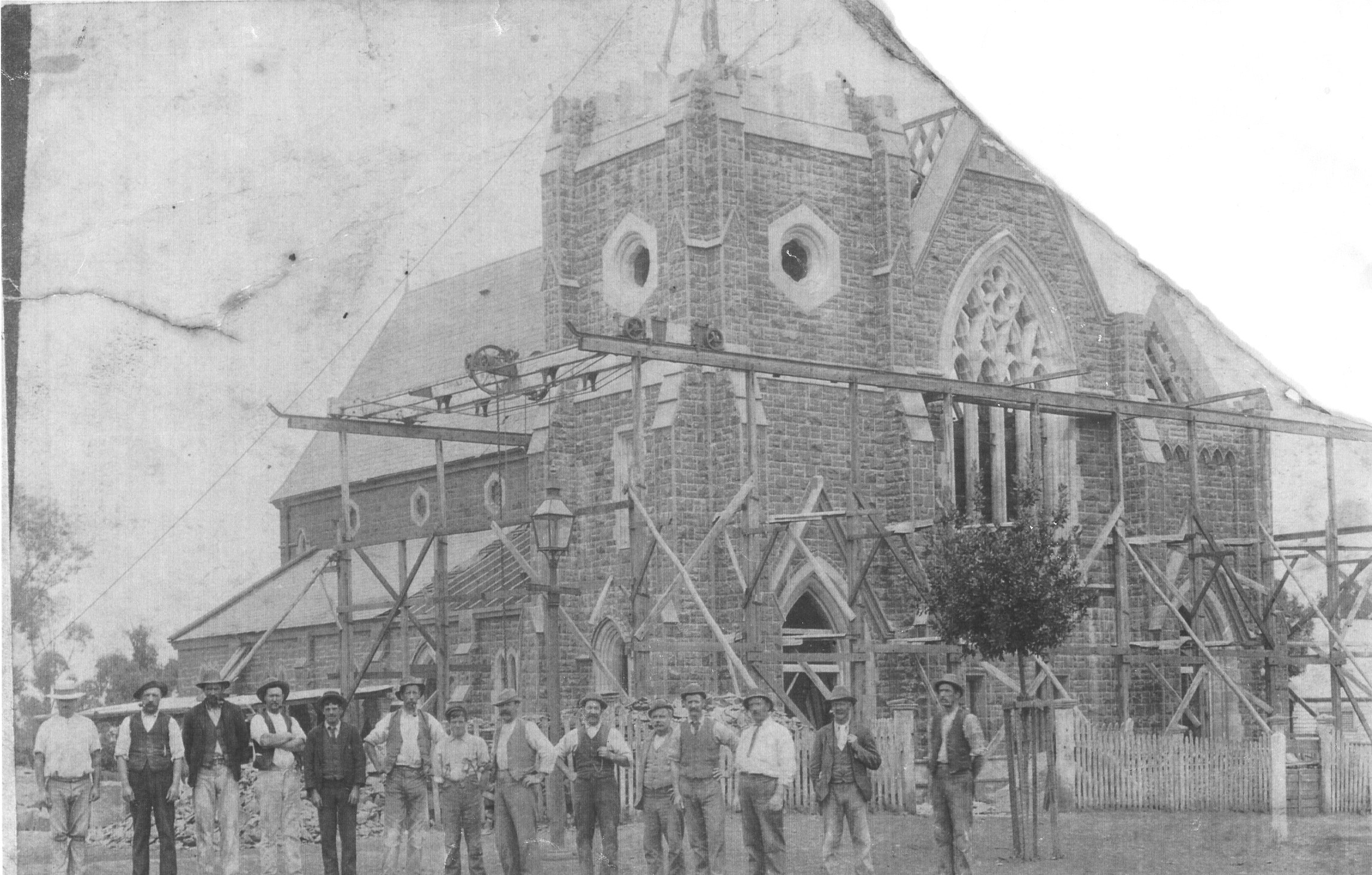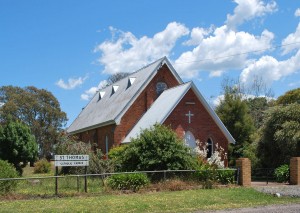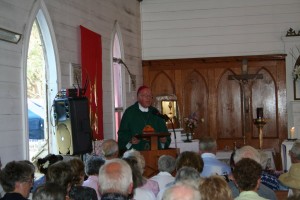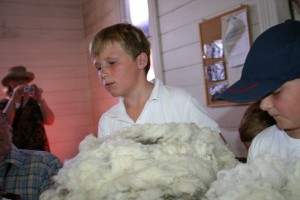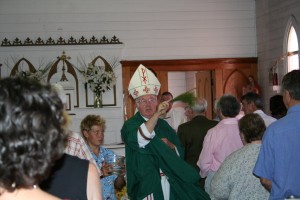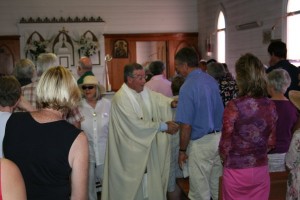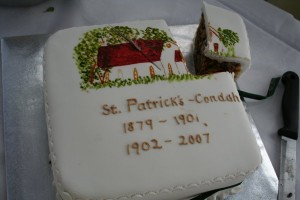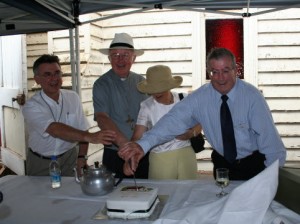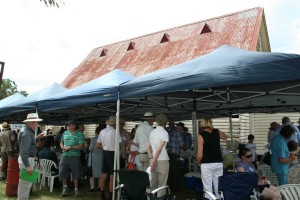St Mary’s Hamilton
From a Little Wooden Chapel ……..
St Mary’s Parish records reveal a great spiritual strength and determination of both clergy and pioneers during early settlement. Through their efforts in laying the foundations of religion and the Catholic Church in the Hamilton district, it is the subsequent generations who reap the harvest of past wisdom and perseverance.
The acquisition of land and erection of the first building of worship, were undertaken by former priests and local settlers in the 1850s. However it was the remarkable energy and dedication of Rev Fr Michael Shanahan – the “Grand Old Patriarch of the Western District” who secured the parish’s foundations. On arrival in 1886, the untiring work of the distant past was in ruins. The parish which once housed “the little wooden chapel on She Oak Hill” was in much need of attention. The establishment of a school was to follow immediately, along with several churches and schools in country areas.
So it reads that during those last 150 odd years, countless clergy have ministered to all within the church and school communities. Just like the immeasurable work of Fr Shanahan and many others, may the ongoing commitment of our clergy and teaching staff continue to be welcomed by the St Mary’s Parish community of today.
– Anne Slattery
The original Parish of Portland, which has been divided six times, was initially part of the Melbourne Diocese 250 miles away.
If we were to look at a map of today, it would convey the immensity of the difficulties which confronted the early priests as they sought to plant the faith in this isolated region. It was an area seventy miles from east to west and one hundred and twenty miles from north to south, enclosing the whole of the area within the Glenelg and Wannon Rivers system. Dense forest spread over much of this terrain. There were no roads, nor were there any bridges in a climate of heavy and consistent rainfall. They rode – for that was the only means of transport available to them, through the trackless bush in search of lonely souls thirsting for spiritual support in the many scattered shepherd’s huts and work gangs. They also had the constant problem of working for the time when they might be able to build churches, however modest. So the pioneer priest laboured on to hand on the Christian heritage.
Taken from “St Patrick’s Church Dunkeld – Parish Centenary Booklet
PARISH TIMELINE
- 1847 May – Fr Patrick Geoghegan, the Vicar of Port Phillip visits the Western District.
- 1848 May – Fr John Kavanagh appointed Clergyman to the Portland Bay District, was widely known as “the clerical tramp”. He was a remarkable pioneer priest travelling vast distances to settlers in the district. Hamilton was part of Portland Mission. First Mass celebrated at Hamilton 22 May 1848
- 1849 Fr John Roe – regular visitor to the Grange and surrounding districts over next 4 years, which included administering the Sacraments as far away as Casterton and Harrow.
- 1853 Bishop Goold travelled the Western District on horseback. His diary notes read “I selected a site in the township most picturesquely situated in the heart of a magnificent country. At present there are but few Catholics, but many Catholics families employed on neighbouring stations and lots of children to baptise”. Hamilton Catholics wrote a letter to the Bishop dated 22 December, requesting a resident Priest.
- 1854 Land allotments were acquired by the Bishop (temporary reservation) between Dinwoodie, Clarendon and Lonsdale Streets Hamilton, previously known as “She-Oak Hill”. Now to be the site for Hamilton’s first Catholic Church/School. History records Hamilton’s faith denomination at this time as being: Roman Catholic – 51 Church of England – 150 Church of Scotland – 30 Presbyterian – 17 and a few Protestants.
- 1856 Commencement of a wooden Church/School building under the guidance of Fr John Bernard Cronin.
- 1857 Fr Shinnick becomes a regular visitor to Hamilton. Completion of building works. “The Roman Catholics of Hamilton have a wooden chapel on a hill, but no services, unless upon the chance visit of a clergyman”. Quote by Hamilton Writer J F Bonwick. The Church/School wooden structure measured 32’ x 20’ x 10’ (feet) at a cost of ₤487 – 5 shillings – 6 pence totally donated by local contributors. First teachers at Common School No. 314 were Mr & Mrs Nicholas Flynn 1858 – 1865. First presbytery built – small four roomed stone house. Fr J Moloney and Fr E McCarthy took charge of Hamilton district up to 1860.
- 1858 School opened for use in June of this year. A School bell hung from a gum tree at the rear of the building. 1860 Brick Chapel/School completed at Coleraine which then became an independent Mission.
- 1861 Two – acre grants were secured at Branxholme and Cavendish for Churches but never used.
- 1862 September – Fr John O’Connell of Portland appointed 1st Pastor/Parish Priest of Hamilton 1863 Planning underway for building of new Hamilton Church designed by Architect William Wardell. Early English style architecture, incorporating Mt Sturgeon stone arches, columns and altar steps.
- 1864 Fr O’Connell oversaw planning & construction of small Chapel at Merino ₤300. Hamilton Presbytery built of granite for ₤1,000. October – Rev Michael Farrelly – 2nd Parish Priest collects funds for the proposed St Mary’s Church costing almost ₤4,000. Architect James Fox.
- 1866 August 12th – Opening of first section of Hamilton’s Gothic Style bluestone Catholic Church with Mt Sturgeon columns, arches and windows. Whole of Church plan only partly completed at this time, due to its members’ limited ability to increase financial support.
- 1867 Commencement of bluestone Church at Penshurst by the energetic and good humoured Fr Farrelly. Opening ceremony 20 May 1869. Land permanently reserved 13 December of this year.
- 1870 Macarthur officially opened its first Church, however by 1885 Fr Shanahan was urging locals to build a more substantial sized place of worship, to accommodate the population growth. 1871 Fr Fennelly – 3rd Parish Priest took charge at Hamilton in February of this year. On Christmas Eve he opened a newly constructed wooden church at Strathmore – between Dunkeld and Glenthompson.
- 1874 Wooden School building completed at Penshurst. 1875 – 1886 Fr Hoyne – 4th Parish Priest from County Kilkenny, Ireland is recorded as completing a ten year term during this period.
- 1886 Fr Michael J Shanahan – 5th Parish Priest began his 45 years of service to the St Mary’s Parish. The “Grand Old Man of Hamilton” earned great respect from all, with much involvement in the Hamilton Public Hospital. Fr Shanahan held a position on the hospital committee from 1886 – 1930. A new brick and bluestone school (front portion of St Mary’s Hall) replaced the 30 year old wooden school/church. The old building was raffled and relocated to Mt Baimbridge Road where it was later destroyed by fire. The former Hamilton Academy was later purchased for use as a Primary School.
- 1887 Macarthur’s tiny bluestone Church 40 feet by 21 feet was built at a cost of ₤538 and officially opened on 9 October. Coleraine’s 25 year old School/Chapel was also in need of replacement to cater for a growing congregation over 150. The years to follow under Fr Shanahan’s guidance saw churches built at Condah, Penshurst, Dunkeld, Glenthompson Wallacedale and Glen Isla. Convents were constructed at Hamilton and Coleraine and three other schools in the western district.
- 1900 Fr Shanahan completed his original plan to build a larger church, with the population now growing to 900 Catholics in the Hamilton area and 350 in surrounding districts. Memorial stone laid on 13 May.
- 1900 December 1st – Blessing and formal opening of the 17 metre extension to St Mary’s Hamilton by Bishop Moore of Ballarat. A 20 metre tower was added some time later. However in 1914 plans to erect a church spire were delayed by the Great War.
- 1903 Coleraine School rebuilt and reopened after closure of years.
- 1905 Loreto Nuns began a Secondary School for girls in the newly established Convent at the former Hamilton Academy. A Primary School for boys and girls followed at the same site.
- 1906 Coleraine made a separate parish.
- 1914 Fr Shanahan celebrated his Golden Jubilee of ordination. St Mary’s Church spire, designed by Architect Frank Hammond and erected to commemorate Fr Shanahan’s Golden Jubilee. The spire and other additions were blessed by the Bishop of Ballarat on 15th October 1916.
- 1929 Supper rooms added to St Mary’s Hall building.
- 1931 Death of Fr Shanahan on 6 December at age of 94. Fr John Kerin – 6th Parish Priest
- 1935 Fr McGloin – 7th Parish Priest
- 1942 Fr W N Close – 8th Parish Priest
- 1949 Fr E V Ryan – 9th Parish Priest
- 1952 Fr Robert Dunworth – 10th Parish Priest
- 1954 Catholic Boys’ School at Monivae Homestead Port Fairy Rd – temporary site for “Sacred Heart College Monivae”. With exception of 65 acres around the homestead it was exchanged in 1971 for a 120 acre Ballarat Road site. Initial intake at the homestead was 38 students in Forms 1 and 2.
- 1956 The relocated College to be named “Monivae” opened in February, staffed by Seven Priests and Four Brothers of Missionaries of Sacred Heart. The first intake of students totalled 65 boarders and 50 day students. Western District boys were earlier educated at privately run schools.
- 1962 Fr Patrick Flanagan from February 1962 – May 1964
- 1968 Maryknoll College, located on Clarendon Street was a girls’ secondary school run by the Good Samaritans. Fr Patrick Flanagan May 1968 to January 1973
- 1970 Maryknoll College matriculation students attended some classes at Monivae.
- 1973 Fr Tom Russell – 11th Parish Priest
- 1974 Monivae began co-education for senior students with full intake by 1977. As no boarding facilities were available to girls, private boarding places were initially sought.
- 1977 Maryknoll College became Junior Monivae campus for Year 7 and 8 until 1998.
- 1984 Fr Patrick Flanagan – 12th Parish Priest until January 1992.
- 1987 Further extensions and renovations undertaken to St Mary’s Church. Design by local Architect, Francis Punch.
- 1992 Fr Peter Hudson – 13th Parish Priest
- 1998 Junior Monivae returned to Ballarat Road.
- 2001 December 9th – Centenary Belltower erected between old and new church for 1889 bell 250 kgs – original property of a Fire Brigade at Eastern Hill, Melbourne. There is no knowledge in our parish history records of how the bell was attained by Fr Shanahan. Naming of Maryknoll Centre also took place this year.
- 2003 Fr Patrick Mugavin – 14th Parish Priest
- 2011 Completion of new St Mary’s Primary School at Hilliers Lane, Hamilton.
- The last member of the Good Samaritan Order farewelled by St Mary’s community.
Information sourced from St Mary’s Parish Archival Records and a book titled “Pioneer Catholic Victoria” by Rev W Ebsworth
Maryknoll Centre
The main building located on Clarendon Street and accessible from Lonsdale Street, originally housed Maryknoll College – a Girls’ Secondary School run by the Good Samaritan Sisters. The school was blessed and opened by Rev J P O’Collins, D D Bishop of Ballarat on Sunday 10 March 1968. Fr R Dunworth was the Parish Priest.
Monivae began co-education for senior students with full intake by 1977. As no boarding facilities were available to girls, private boarding places were initially sought. From 1977 Maryknoll College became Junior Monivae campus for Year 7 and 8 until 1998.
In 1998 Junior Monivae moved to Ballarat Road campus and a Parish Task Force explored several proposals for leasing the building to interested parties. The Task Force also considered building modern units for elderly parishioners. Following submissions from several parishioners during 2000, the parish Council moved to retain the buildings and land for Parish purposes and formally named the buildingMaryknoll Centre.
Parish Council permitted buildings to be used an Outreach and Community Centre. Financed by the Parish, considerable works were carried out in 2003 to upgrade the buildings. A large number of private donations of equipment and furnishings and hundreds of hours of voluntary labour enabled the Centre to become operational. All painting, cleaning and minor maintenance that continues to be carried out is from voluntary labour.
St Patrick’s Condah
Newspaper Article – Hamilton Spectator Thursday 22 February 2007
CONDAH’ s St Patrick’s Catholic Church closed its doors on Sunday after 127 years service to the community.
The weatherboard red tin-roofed building was bursting at the seams, as families who once attended every Sunday returned to say goodbye.
Bishop Peter Connors, Fr Pat Mugavin and Fr Paul Gurry officiated a final 10.30am mass. The service ended with a short ceremony outside. The congregation formed a guard of honour, while the clergy led by Bishop Connors officially closed the church.
Lunch was then served under a marquee where families and friends reminisced about the days gone by. The original Condah church was built in 1879 for ₤200 (pounds).
In 1901 it burnt down during the Black Friday fires and was rebuilt the following year in 1902 for ₤400. That same year Condah became attached to the parish of Hamilton.
In recent times the congregation has numbered just give people, thus the decision to close the church had been made. It is yet to be decided what will happen to the money from the sale of the land, building and its contents. Fr Gurry said some suggestions had been offered including the building of a church in East Timor but that the final decision was to be made by the finance committee whose president is Fr Gurry’s brother.
Furniture and other items that had been donated to the church by local families over the years were to be moved to St Mary’s in Hamilton as a remembrance of the Condah church community.
A community that was “par excellence” according to Fr Gurry and, he said, whose members cared for one another, shared joys and sorrows and kept up relationships. The church committee organised the event and the publication of booklets compiling people’s memories of St Patrick’s Church, Condah.
Our Diocesan Community Magazine – March 2007
That Little Wooden Church………
Extreme weather conditions did not deter the one hundred and twenty plus crowd attending the recent closure of Condah’s St Patrick’s Church.
Located just off the Hamilton – Portland Road, the aged church building spilled over with visitors, welcomed back by the local community to celebrate the life of the church. Descendants of Condah’s pioneering families travelled great distances to share wonderful memories of a once thriving congregation, with some members participating in the closing service.
The past few years saw Sunday masses reduced to a handful of devoted worshippers, including the Canavan and Godfrey-Smith families, along with the occasional visitor. Condah’s first church opened in 1879 but fell victim to the devastating Black Friday fires in 1901. The community rallied to rebuild the current church in 1902 at a cost of ₤400 (pounds).
Bishop Peter Connors officiated the closing Mass on Sunday 18 February 2007, along with Fathers Pat Mugavin and Paul Gurry. The occasion had special significance for Fr Gurry whose family were past residents in the district. A book prepared for the day included memoirs from past parishioners. Fr Gurry wrote of happy memories of a country church, including “enunciating Latin with great enthusiasm” during his role as Altar Boy. Others spoke of the warmth and love amongst a community who gathered regularly, united in faith and friendship.
Stories such as …..
The relief of a young parishioner, appreciating the privacy of an enclosed confessional at St Patrick’s compared to kneeling at altar rails in full voice and view of the congregation, as was the case in neighbouring churches. The newly appointed School Teacher generously offered the lend of a cream coloured pony by a local bachelor, enabling travel to weekly mass some four miles from home. She was to marry the owner of that horse in 1949, eventually arriving more sedately some time later on four wheels.
The commitment of the faithful is none more evident than in a farming family who’s Sundays started at 3am to enable timely arrival for 8.45am mass. A four-mile bike ride to church followed five hours of milking cows in the dark and feeding animals. With a member of that same family devoting 17 years to service as an Altar Boy.
So St Patrick’s doors have closed one final time, no longer to be filled with the great characters whose dedication to the life of the church now becomes history.
Anne Slattery
Personal Memoirs of Earlier Times ………….
“Church was an important part of life when staying at Condah, and my memories are of the small church, “our seat” (the Gurry’s) up the front on the left side and especially the care my grandmother took to always prepare the thermos and sandwiches for the priest after Mass. “
“Parishioners names in the 1920’s and 30’s – Black, Bellamy, Clarke, Dwyer, Gray, Gurry, Malseed, Murphy, McKenzie, McDonald, O’Shea, Polack, McCarthy.”
“I can hear Grandma calling from the grave – You should have gone to Mass more often!”
“The best thing about the CondahChurch was that it had its very own confessional box down the back and I didn’t have to kneel at the Altar rails.”
“I can still see Flags Flanagan with his feet at quarter to three, telling us we must take communion in both forms.”
“The Mission Priests were frightening to a young boy – long robes, sandaled feet and booming voices.”
“For our father to travel to Condah by car to see his mother was not possible, as our wartime ration of petrol was four gallons a month.”
“My most ardent prayers were said after Mass, silently asking that Lucy (the horse) would stand until I was safely in the saddle. Riding home was never dull.”
“We believed the priest was God – all dressed up in his heavenly robes. So we behaved accordingly. We were the best behaved children in the Church!”
“Peter – the Lebanese Hawker often stayed at “Raheen” and would say the rosary with us answering in Arabic.” Peter travelled the Western District on horseback for 35 years selling household linen and clothing.
“An Annual event, the Catholic Ball…..for days before, the women baked for the supper. On the night a copper full of boiling milk coffee would top it off. Trays of sausage rolls and cream puffs from the wood-fired oven at home.”
Following are extracts from the Portland Guardian Newspaper 1879 – 1901
15 February 1879
As the Roman Catholic Church at Condah is now all but completed, the consecration will not be long delayed. The building is of wood and substantially built; the roof is of iron, with a quick pitch and as the height to the eaves is at least fourteen feet the ventilation is good.
The Rev J O’Donoghue of Portland has already celebrated Mass in the church. When finished the structure will have cost ₤200 and it is not improbable that in time, a school will be added to the church. At present young children in the neighbourhood have a long distance to travel.
7 April 1879
On Sunday last, March 30th, the Catholic Church at Condah was solemnly opened and blessed by Bishop O’Connor. Accompanied by Fr O’Donoghue, his Lordship proceeded to Condah on Sunday morning from Heywood. He was met on the road out some miles by a large number of resident Catholics. The ceremony of blessing the church commenced 11 o’clock.
Mass was celebrated by Fr O’Donoghue, at the end of which his Lordship taking as his text the words from the Gospel of St John – “He that is of God, heareth the words of God”- preached a very elegant and impressive sermon. He was listened to with the greatest attention, not only by members of his own flock, but by a large number of persons of other denominations who were present, who expressed themselves highly pleased with what they had heard.
There were about 200 persons present, several having come from Portland, Heywood and Branxholme. The Catholics of Condah are to be congratulated on having at length a little Church in which they can assemble to worship God. The church is 40ft long by 20 ft wide, quite large enough for the congregation. When the ceremony was ended a few of the leading gentlemen presented an address to his Lordship, congratulating themselves on the auspicious occasion which brought him amongst them for the first time and alluding to the kind assistance they had received from their Protestant friends – to which his Lordship made a very kind and feeling reply. During his stay at Condah, Dr O’Connor was the guest of Mr McDonald.
Hamilton Spectator 9 February 1901
The Condah Catholic Church building, together with the homes of Mr McDonald and dozens of other residents, were destroyed by fire on the previous day during Black Friday Fires. Newly laid carpet at a cost of ₤30 and a recently acquired communion plate were amongst the items destroyed in the fire.
……………………………………………………………….
St Patrick’s Dunkeld
Formerly known as Mt Sturgeon, Dunkeld was aptly renamed in 1854 by early Scottish settlers, likening the district to their previous homeland.
Their devotion knew no bounds, as Catholic residents were united in faith praying the Rosary between visits from travelling priests. As these visits were only enjoyed once or twice a year, they were also a time for celebrating the Sacraments. The dining room in the district Coach Station, known as the Woolpack Inn was the venue for Dunkeld’s first church service.
Fr Kavanagh, Portland’s first resident priest in 1848, travelled a vast area between stations including Hamilton (Grange) and Dunkeld (Mt Sturgeon), earning him the title of “clerical tramp”. It was not until 1875 that a small wooden structure was built as a place of worship in Dunkeld on two acres, for a sum of 150 pounds.
The early settlers in the area included a high ratio of Irish Catholics who struggled to provide for their family, but continued to commit their financial offering to the church. However the following ten year period saw many district people losing that commitment and devotion to the Catholic faith.
Following Fr Shanahan’s arrival in 1886 the need to re-build a new Church community and building was evident. On completion of the early English brick structure costing 800 pounds, Mass was celebrated fortnightly from 1913.
Sermons citing “Hell” and “Damnation” rang out from the pulpit, but did not deter the devoted, including a regular visit by the local cockatoo that would fly onto the altar interrupting proceedings. History well records Fr Shanahan travelling for many years by horseback on his brilliant white stallion which later included a buggy.
The souls of many other clergy live on in St Patrick’s history. They are forever remembered for their good humour, wit and untiring contribution to the church’s growth spanning 130 years. Post War times saw an end to many fundraising events that previously brought the whole church community together, like annual balls and euchre parties. Those events diminished at the introduction of the “planned giving scheme”.
In 1975 Ursula Griffin dedicated a book to St Patrick’s centenary, in which she quotes:
“The real memorial to the work of the Church and its forebears is enshrined in the hearts of the people of today and over the years.”
St Patrick’s today, whilst much smaller in numbers, remains a united community within our parish.
Anne Slattery
Parish Team Member
St Thomas’ Glenthompson
The commitment of the early day priest is never more evident than when reading the pages of a parish history.
Horse and buggy was their modern form of transport, which replaced the earlier means of travel by bicycle.So it was, for the priests who commuted from Hamilton to serve the congregation of Glenthompson in 1904. On November 27th of that year a new church was constructed on land donated by a Mr John Brady.
In keeping with their loyalty and devotion to the Catholic faith, local members cleared the Church debt through fundraising and generous donations. Over time the building was refurbished, with the organ being the first purchase to replace one regularly borrowed for special occasions.
Family names etched into the Glenthompson faith community history include: Brady, Burgess, Fry, Hayes, Higgins, Kearney, Malcolm, Mahony, Walsh and Wright.
Prior to the establishment and growth of the Glenthompson area, worshippers attended the Catholic Church at Strathmore (3 miles east- identified as “Yuppeckiar”) opening in December 1871. Newly settled farmers in surrounding districts also travelled long distances by horse and buggy. On the return trip home many gathered at a local property for breakfast after fasting. However following the completion of the Ararat – Portland Railway line in 1877 and Glenthompson Station, this caused a shift in the population growth, urging a local church construction.
In reading St Thomas’ history the commitment of parishioners spanning over 100 years was also apparent. Regardless of their involvement within the church, the Glenthompson congregation showed great strength and support to both the clergy and their fellow members when needed.
While there have been many celebrations of the sacraments over time, the St Thomas community also reflect on the lives of many district people who are the history of the church. Numerous occasions have been marked in Church records as significant. Even more evident is the fellowship which emerges from a small country community.
Information compiled from “St Thomas’ Centenary Church History 1904 – 2004″
Anne Slattery
Parish Team Member
St Malachy’s Macarthur
Had the town of Macarthur retained its aboriginal name, it would be known today as Eumerella – meaning Valley of Plenty.
A read of Simone Dalton’s book “Boring? Not Likely – Great Characters of Macarthur” introduces us to a town rich in amazing characters since 1857. Long before the boom of soldier settlement in the 1950s, the strength of community spirit was evident and those living in the past, helped shape the town’s future.
Macarthur is rightly proud to boast its war heroes, authors, architects and many other notable residents. They can also boast their first pub fully operational long before the town was even surveyed. The book speaks of the resilience, sheer guts and determination of town people who rose above issues of division including racism.
The following article submitted by parishioner Colleen Hill in 2006 tells of St Malachy’s from the beginning. With clergy able to put their theological difference aside, churches united in support of one another during the establishing years. Some even shared a church bell.
While many precious stories of the past have gone with their owners, others remain happy memories of today’s parishioners. Church balls were special occasions that brought both Catholic and Protestants together, not allowing religion to divide their friendship. Another memorable church celebration would have to be the triple wedding of the Lucas daughters, whose family of 12 lived directly across the road. Then there was Fr Kavanagh who relied on the altar boys to tap his foot if his sermons went too long. That same altar boy recalls the Hamilton servers swigging wine when the priest wasn’t looking.
Reference: “The History of St Malachy’s Church 1887 – 1987″ and “Boring? Not Likely” by Simone Dalton
Anne Slattery
Parish Team Member
Before there was any Catholic Church in Macarthur the local parishioners celebrated Mass in the Twist family’s home. Priests from Hamilton would service the area at irregular intervals.
In 1870 the first Catholic Church officially opened with Mass by Rev Fr Farrelly, however by 1885 Fr Shanahan urged the locals to build a more substantial sized church to accommodate the population growth. A church built from local stone taken from a property on Lake Gorrie Road was completed at a cost of 530 pounds. Through the generosity of other denominations and parish community fundraising, a total of 120 pounds was raised locally.
With thanks to the interdenominational friendship of that time, St Malachy’s were grateful for the lend of an organ as accompaniment for the opening mass on 9th October 1887. Five years later and more fundraising saw a new organ for the church. Additional renovations to the building followed spanning the next ninety years.
Whilst attendance numbers may have risen and fallen at St Malachy’s the spirit has remained steadfast thanks to the dedication of the local parishioners.
Colleen Hill
St Joseph’s Penshurst
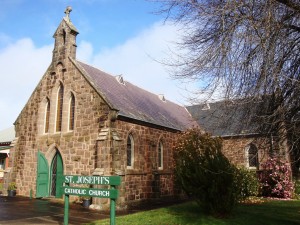 In 1907, the Bishop and his advisors transferred the community of St. Joseph’s, Penshurst out of the Parish of Hamilton as it was then situated and the community of St. Joseph’s, Hawkesdale out of the Parish of Koroit to create the new Parish of Penshurst. Some months later Fr John Walsh took up residence as the first parish priest of Penshurst.
In 1907, the Bishop and his advisors transferred the community of St. Joseph’s, Penshurst out of the Parish of Hamilton as it was then situated and the community of St. Joseph’s, Hawkesdale out of the Parish of Koroit to create the new Parish of Penshurst. Some months later Fr John Walsh took up residence as the first parish priest of Penshurst.
The nave of the present blue-stone church had been built in 1864 – being serviced for Mass at first from Port Fairy and later from Hamilton. The transepts and present sanctuary and sacristy were added in 1897 under the inspiration of the then parish priest, Fr Shanahan of Hamilton and were opened and blessed by Bishop Moore in November 1897. The present presbytery was built in 1926, when Fr Manning was Parish Priest.
Along the way St. Joseph’s School was built in 1874, then re-built and re-furbished again and again, until we arrive at the pleasant and well-equipped building that operates today. From 1874 until 1945, the school was staffed by lay women, then the Sisters of Mercy staffed the school, in latter years with lay staff, until 1975. Lay teachers remained in the school after the departure of the Sisters and this continues today under the leadership of Mr. Ben van de Camp as principal.
With notable families like Twomeys and O’Briens in the early days and more recently the Kellys and Ryans and priests such as John Murphy, James Hyland, Michael Glennen, Patrick Bushell and in later times Meredith Delahenty, Thomas Brophy and Lawrence O’Toole – the parish continued, more or less successfully, over the intervening century. The community of St. Joseph’s, Caramut was transferred from Mortlake to Penshurst in the second half of the 20th century.
This brings us to 2012. Over the last two or three years it became obvious, that with the serious decline in the clergy numbers, the reduced numbers in the parish and the ageing nature of the congregation, the present parish priest would not be replaced when his term finished in one way or other. This was accepted as inevitable by the parishioners, knowing too that the present incumbent was a number of years beyond the accepted retiring age.
Rather than let the matter drift on until that retirement became a reality and be faced with an emergency situation, the Parish Council decided to be pro-active and have some possible plan in mind. Various options were considered, but most were considered to be of a stop–gap nature and the decision was for a ‘final solution’- namely that the Parish of Penshurst be carefully wound up and its various components be attached to the neighbouring parish to which they had a geographical, economic social relationship- Penshurst to Hamilton, Hawkesdale to Koroit and Caramut to Mortlake. Shades of 1907!!
With the general agreement of parishioners, the plan was to proceed cautiously. First to get the OK from the Bishop and to spend the last quarter of 2011 setting things in motion and preparing the community for life without a resident parish priest. So that the Parish of Penshurst would be closed down sometime in 2012 and the present incumbent Parish Priest would quietly ride off into the sunset.
Following the demands of Canon Law, the Bishop got the permission of the Council of Priests to ‘suppress’ (canonical terminology) the parish of Penshurst and all was expected to fall into place in due course. The respective parish priests of Hamilton, Koroit and Mortlake agreed to accept the added work load of another community.
But as with many well laid plans it all had to be put on fast forward when the current parish priest had a slight mishap which put him out of action for two months. As a consequence the Bishop issued the ‘suppression’ document on September 22nd 2011 and it was therefore a case of ‘coming ready or not’. There is a sadness in the ending of a parish, but a wonderful lesson for us in the foresight and courage of the priest and parishioners in looking to the future and ensuring their faith can continue to be expressed in new ways.
And so endth the lesson of Penshurst with thanks to Fr. Frank Madden.
Article taken from the Ballarat Diocesan E-News – 7 February 2012.
Celebrating The Year of the Priest
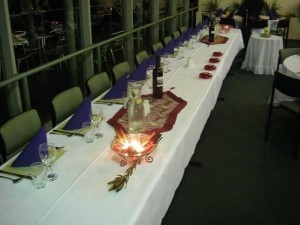 Preparing the tables[/caption]
Preparing the tables[/caption]
In 2009 Pope Benedict XVI proclaimed 2009 – 2010 the Year of the Priest and called on the Church to support their Diocesan clergy.
To celebrate locally, the parish community of St Mary’s recently welcomed the return of past serving clergy to Hamilton, including Missionaries of the Sacred Heart (MSC) priests who established Monivae College.
A parish dinner held at the Hamilton Golf Club included a night of entertainment and nostalgic memories of parish life.
Lifetime resident and parishioner Mr Jim Eveston in his address to the guests, reflected on the lives of many past clergy and the influence their guidance and support had on the faith formation of the parish community. The spiritual strength and personal commitment that past priests had devoted to the Hamilton Parish continues to be fondly remembered with gratitude by St Mary’s parishioners today.
Fathers Eugene McKinnon (Terang), Peter Hudson (Swan Hill) and John Monaghan (Quambatook) were among ten Priests in attendance who recalled memorable and humorous events that had occurred during their service throughout the parish.
Fr Andrew Hayes of Casterton, whose ministerial role includes nine churches in the widespread parishes of Coleraine, Casterton, Edenhope and Harrow shared his much loved musical talent to the delight of the audience on the night.
The present St Mary’s site was first acquired in 1853 by Bishop Goold. As revealed in the Bishop’s historical diary notes, he travelled the Western District on horseback – “to select a site in a township most picturesquely situated in the heart of a magnificent country”. The first Church/School building was a wooden structure built in 1856 at a cost of ₤488 (Pounds). For the next five years the Catholics of Hamilton were reliant on visiting clergyman until the appointment of their first Pastor (Parish Priest) Fr J O’Connell.
In the immediate years to follow, the dedication of the clergy knew no bounds in overseeing the building of Churches and Schools in many parts of the Western District.
One such Priest Fr Michael Shanahan devoted forty-five years of service to St Mary’s Parish from 1886. Dubbed “The Grand Old Man of Hamilton” Dean Shanahan was responsible for the establishment of places of worship and education in as many as nine towns in the south west.
The immeasurable work of the past continues in today’s Church through the ongoing commitment of dedicated clergy & staff, along with the many volunteers who willingly fill the void of available Priests, assisting in a number of ministerial roles.
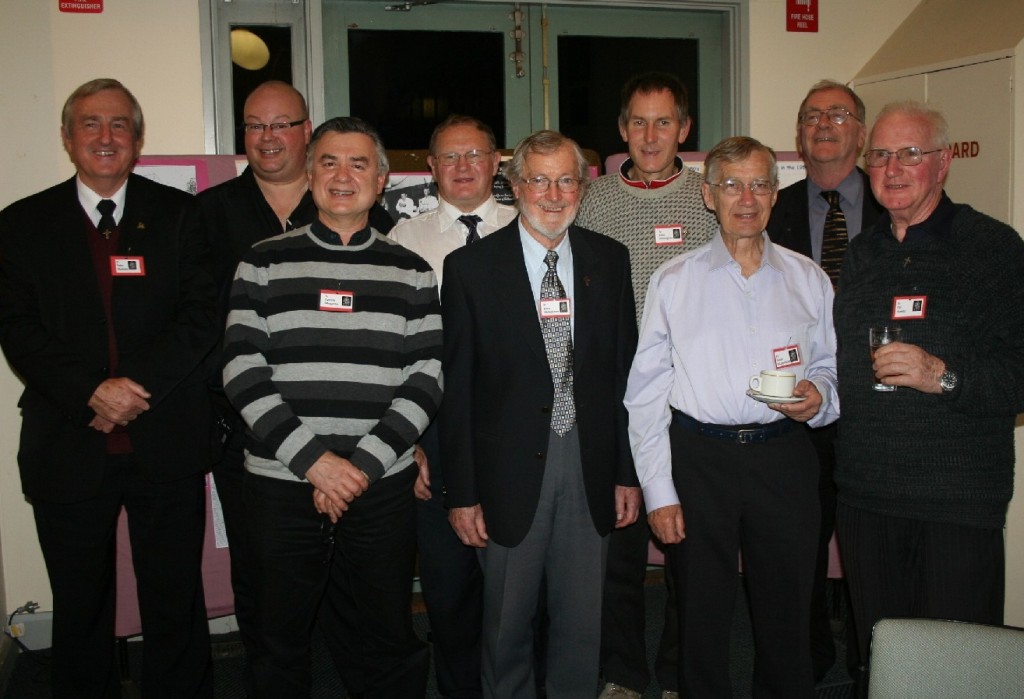
Photo above: Back Row L to R: Fr Peter Hudson – Fr Andrew Hayes – Fr Eugene McKinnon – Fr John Monaghan – Fr Paul Castley MSC
Front Row L to R: Fr Patrick Mugavin – Fr John McKinnon – Fr Noel Mansfield MSC – Fr Pat Austin MSC
– Anne Slattery
Closure of St Patrick’s Condah
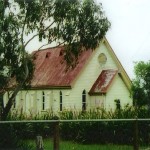 Newspaper Article – Hamilton Spectator Thursday 22 February 2007
Newspaper Article – Hamilton Spectator Thursday 22 February 2007
CONDAH’ St Patrick’s Catholic Church closed its doors on Sunday 18th February after 127 years service to the community.
The weatherboard red tin-roofed building was bursting at the seams, as families who once attended every Sunday returned to say goodbye.
Bishop Peter Connors, Fr Pat Mugavin and Fr Paul Gurry officiated a final 10.30am mass. The service ended with a short ceremony outside. The congregation formed a guard of honour, while the clergy led by Bishop Connors officially closed the church.
Lunch was then served under a marquee where families and friends reminisced about the days gone by. The original Condah church was built in 1879 for ₤200.
In 1901 it burnt down during the Black Friday fires and was rebuilt the following year for ₤400.
In recent times the congregation has numbered just five people, thus the decision to close the church had been made. It is yet to be decided what will happen to the money from the sale of the land, building and its contents. Fr Gurry said some suggestions had been offered including the building of a church in East Timor but that the final decision was to be made by the finance committee whose president is Fr Gurry’s brother.
Furniture and other items that had been donated to the church by local families over the years were to be moved to St Mary’s in Hamilton as a remembrance of the Condah church community.
A community that was “par excellence” according to Fr Gurry and, he said, whose members cared for one another, shared joys and sorrows and kept up relationships. The church committee organised the event and the publication of booklets compiling people’s memories of St Patrick’s Church, Condah.
[gallery link="file" orderby="rand"]Our Diocesan Community Magazine – March 2007
That Little Wooden Church………
Extreme weather conditions did not deter the one hundred and twenty plus crowd attending the recent closure of Condah’s St Patrick’s Church.
Located just off the Hamilton–Portland Road, the aged church building spilled over with visitors, welcomed back by the local community to celebrate the life of the church. Descendants of Condah’s pioneering families travelled great distances to share wonderful memories of a once thriving congregation, with some members participating in the closing service.
The past few years saw Sunday masses reduced to a handful of devoted worshippers, including the Canavan and Godfrey-Smith families, along with the occasional visitor. Condah’s first church opened in 1879 but fell victim to the devastating Black Friday fires in 1901. The community rallied to rebuild the current church in 1902 at a cost of ₤400 (pounds).
Bishop Peter Connors officiated the closing Mass onSunday 18 February 2007, along with Fathers Pat Mugavin and Paul Gurry. The occasion had special significance for Fr Gurry whose family were past residents in the district. A book prepared for the day included memoirs from past parishioners. Fr Gurry wrote of happy memories of a country church, including “enunciating Latin with great enthusiasm” during his role as Altar Boy. Others spoke of the warmth and love amongst a community who gathered regularly, united in faith and friendship.
Stories such as …..
The relief of a young parishioner, appreciating the privacy of an enclosed confessional at St Patrick’s compared to kneeling at altar rails in full voice and view of the congregation, as was the case in neighbouring churches. The newly appointed School Teacher generously offered the lend of a cream coloured pony by a local bachelor, enabling travel to weekly mass some four miles from home. She was to marry the owner of that horse in 1949, eventually arriving more sedately some time later on four wheels.
The commitment of the faithful is none more evident than in a farming family who’s Sundays started at 3am to enable timely arrival for 8.45am mass. A four-mile bike ride to church followed five hours of milking cows in the dark and feeding animals. With a member of that same family devoting 17 years to service as an Altar Boy.
So St Patrick’s doors have closed one final time, no longer to be filled with the great characters whose dedication to the life of the church now becomes history.
Anne Slattery
Personal Memoirs were shared on the day, of Earlier Times ………….
“Church was an important part of life when staying at Condah, and my memories are of the small church, “our seat” (the Gurry’s) up the front on the left side and especially the care my grandmother took to always prepare the thermos and sandwiches for the priest afterMass.“
“Parishioners names in the 1920’s and 30’s – Black, Bellamy, Clarke, Dwyer, Gray, Gurry, Malseed, Murphy, McKenzie, McDonald, O’Shea, Polack, McCarthy.”
“I can hear Grandma calling from the grave – You should have gone to Mass more often!”
“The best thing about the Condah Church was that it had its very own confessional box down the back and I didn’t have to kneel at the Altar rails.”
“I can still see Flags Flanagan with his feet at quarter to three, telling us we must take communion in both forms.”
“The Mission Priests were frightening to a young boy – long robes, sandaled feet and booming voices.”
“For our father to travel to Condah by car to see his mother was not possible, as our wartime ration of petrol was four gallons a month.
“My most ardent prayers were said after Mass, silently asking that Lucy (the horse) would stand until I was safely in the saddle. Riding home was never dull.”
“We believed the priest was God – all dressed up in his heavenly robes. So we behaved accordingly. We were the best behaved children in the Church!”
“Peter – the Lebanese Hawker often stayed at “Raheen” and would say the rosary with us answering in Arabic.” Peter travelled the Western District on horseback for 35 years selling household linen and clothing.
“An Annual event, the Catholic Ball…..for days before, the women baked for the supper. On the night a copper full of boiling milk coffee would top it off. Trays of sausage rolls and cream puffs from the wood-fired oven at home.”
Photos Below: Rev Bishop Connors officiated at Condah’s Closing Mass – February 2007
Symbols representing the life of Condah parishioners were presented at the Altar during the Offertory procession.
Bishop Connors blessing the Condah Congregation at the Closing Ceremony February 2007
Rev Fr Paul Gurry concelebrating Mass and greeting returned parishioners
Cutting of the Celebratory Cake at Condah’s Church closure.
Parishioners gathered during lunch and reminisced about their spiritual life in Condah.
[caption id="attachment_923" align="alignleft" width="150"]
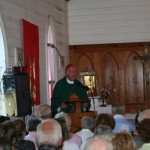 Rev Bishop Connors officiated at Condah’s Closing Mass – February 2007[/caption]
Rev Bishop Connors officiated at Condah’s Closing Mass – February 2007[/caption]

